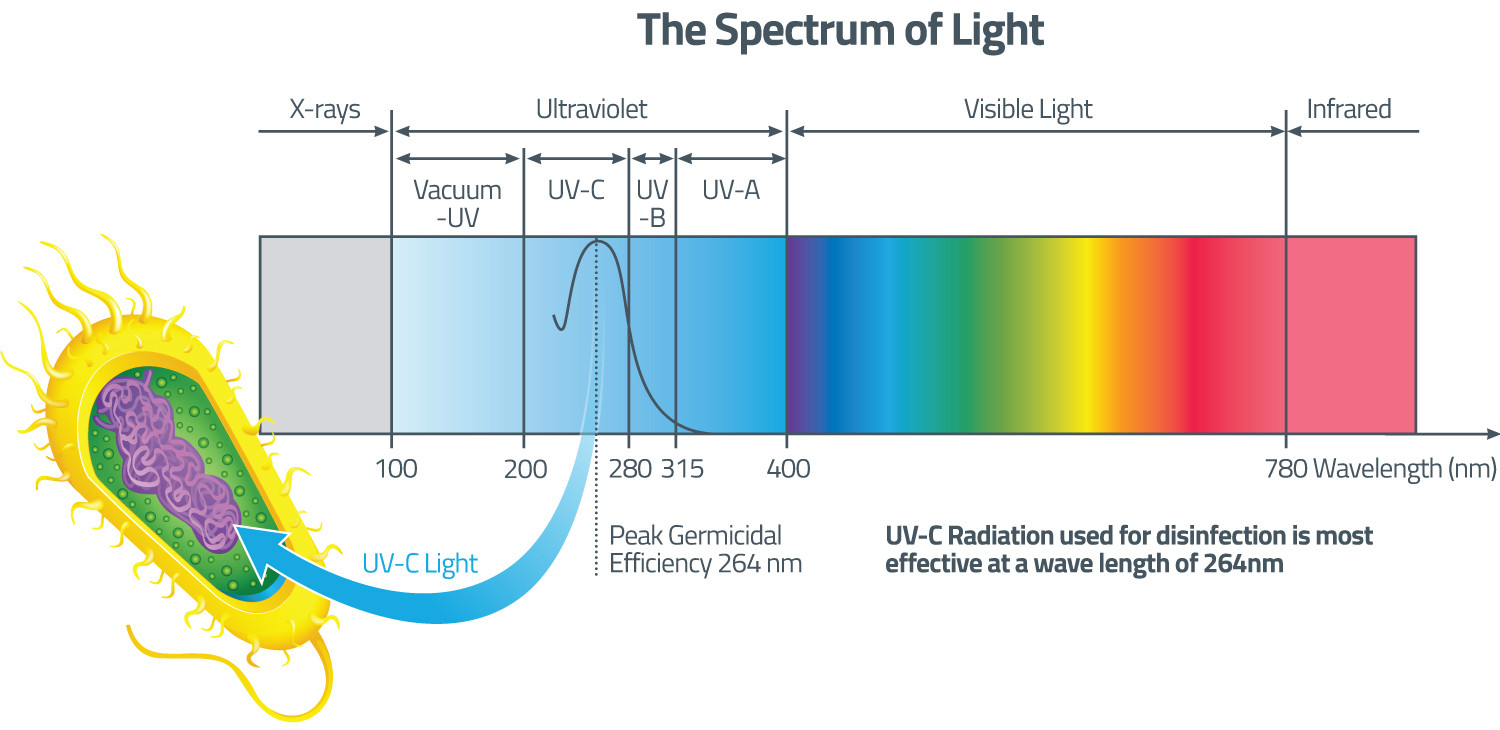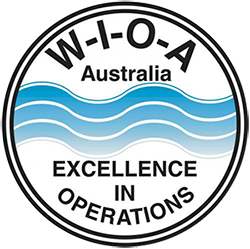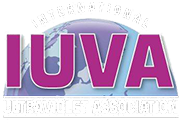Knowledge Centre
UV disinfection. Your questions answered.
What is UV disinfection?
UV disinfection is a technology that uses Ultra-Violet light in the germicidal wavelength range between 200 and 300 nanometers. The optimum UV wavelength for UV disinfection is 264 nanometers which is located within the UV-C spectrum.
When microorganisms are exposed to germicidal wavelengths, the high energy associated with UV-C UV light is absorbed by the DNA of bacteria, viruses, spores and other pathogens. This absorption causes abnormalities within the DNA to occur, resulting in the microorganism being destroyed outright or rendered incapable of reproducing and infecting.

How does a UV disinfection system work?
A UV disinfection system utilises UV light in the germicidal wavelength range (254 nanometers) to disinfect water, surfaces or air. It combines a number of components to allow the UV-C light to penetrate the target material. These include one or multiple UV lamps and quartz thimbles (sleeves) enclosed in a housing. There are two main types of UV disinfection system housing, Reactor or Channel, with each suited to different applications.
A Reactor system is typically made from 316 grade stainless steel, although some inferior quality products use 304 grade stainless steel. PVC or HDPE reactors are also used where liquids with high total dissolved solids (TDS) or corrosive properties require disinfection. Reactor systems will contain one or multiple UV lamps which are installed within quartz thimbles within the reactor itself. Quartz thimbles allow UV light to penetrate liquids while ensuring the liquids cannot come into direct contact with the UV lamp, which would cause the lamp to fail. A reactor will have an inlet and an outlet port positioned at opposite ends. Lamps are most commonly installed through the centre of the reactor with water flowing parallel to them. In some systems, the lamps are installed adjacent to the water flow.
Channel UV disinfection systems are commonly used at large wastewater treatment plants. Quartz sleeves and lamps are again either installed adjacent or parallel to the water flow within the existing channels of the treatment plants. As the channels are wide, multiple UV lamps are used to ensure an even UV dose distribution is achieved.
Both type of UV disinfection systems are powered by controllers which can have a number of features depending on the project needs. Basic controllers include electronic ballasts, lamp fail indicators and alarms. More sophisticated controllers run auto wiping quartz systems, UV intensity monitors and can be remotely monitored or controlled.
What are the different types of UV-C germicidal lamps?
There are a number of UV-C lamp variations and their individual characteristics are suited to different applications.
- Standard Low Pressure (LP) UV Lamps – Standard Low Pressure (LP) UV Lamps are suited to applications where flow rates are lower and exposure time can be longer. They have low operating currents usually between 180 mA and 425 mA and range from 10W to 40W in power.
- Low Pressure High Output (LPHO) UV Lamps – Low Pressure High Output (LPHO) germicidal lamps operate between 600 mA and 800 mA and are usually in T5 or T6 configuration (15mm or 19mm OD). Their output is approximately two times that of standard Low Pressure (LP) germicidal lamps, making them suitable where there are larger flow rates or UV dose requirements are greater. They are available in the same lengths as standard Low Pressure (LP) germicidal lamps.
- Low Pressure High Output (LPHO) Amalgam UV Lamps – Low Pressure High Output (LPHO) Amalgam UV Lamps offer three to four times higher power than standard LP and LPHO UV Lamp types. The use of amalgam allows higher lamp current (1 – 10A) and power ranges from 120W to 1000W. The lamp design contains more robust filaments that are able to withstand higher current operations. Low Pressure Amalgam UV Lamps are designed for stable operation over wide ambient temperature range.
There are two main types of Low Pressure Amalgam UV lamps: Spot Amalgam UV Lamps and Pellet Amalgam UV Lamps. Spot Amalgam UV Lamps have mercury amalgam applied on the inner surface of the lamp in spots where Pellet Amalgam UV Lamps have mercury amalgam applied outside of the lamp arc. Low Pressure High Output (LPHO) Pellet Amalgam UV Lamps have shown to provide a greater UV output in variable power or dimming UV disinfection systems in comparison to the Low Pressure High Output (LPHO) Spot Amalgam version.
- Medium Pressure (MP) UV Lamps – Medium Pressure (MP) UV Lamps are suited to speciality applications or where large UV doses are required at high peak flow rates. Medium Pressure (MP) UV Lamps emit greater UV-C outputs in comparison to Low Pressure High Output (LPHO) UV Lamps. Medium Pressure (MP) UV Lamps also produce multiple wavelengths (polychromatic) whereas Low Pressure (LP) and Low Pressure High Output (LPHO) UV Lamps produce single wavelengths (monochromatic). For this reason, Medium Pressure (MP) UV Lamps perform better in the reduction of chloramines in swimming pools compared to Low Pressure High Output (LPHO) UV Lamps.
What are UV lamps used for?
UV lamps are used in UV disinfection systems to inactive and destroy bacteria, viruses and mould spores. Unlike chemical treatments, the process of UV disinfection is environmentally friendly. UV lamps can be applied in a number of applications from water treatment to surface and air UV disinfection.
Are UV lamps dangerous?
UV Lamps need to be handled and operated with caution. UV lamps generate radiation that is harmful and human exposure should be vigorously prevented. UV disinfection systems should always be operated by properly-trained personnel who have been equipped with installation, operation and maintenance manuals.
| Lamp Characteristic | LP & LPHO | LPHO Amalgam | MP |
|---|---|---|---|
| Emission | Monochromatic | Monochromatic | Polychromatic |
| Lifetime (hours) | 9,000 - 12,000 | 12,000 - 16,000 | 5,000 - 8,000 |
| Efficiency | 30% - 40% | 30% - 40% | 12% - 16% |
| Temperature Influence | High | Low | Low |
| Power Consumption | Low | Low | High |
| Intensity Level | Low | Low | High |
What is the UV dose required to kill bacteria?
UV effectiveness is determined by UV dose. The higher the UV dose, the better the disinfection. Some micro-organisms are more susceptible to UV than others, however as a general rule, a UV dose of 40 mJ/cm² (400 J/m²) is sufficient for comprehensive disinfection of virtually all human pathogens in drinking water. Larger UV doses targeting specific microorganisms or undesired water-borne chemicals are required in certain industries.
How is UV dose calculated?
Sophisticated Computer Fluid Dynamics CFD and average UV dose or fluence rate (irradiance) software programs are used to design UV disinfection systems by calculating their UV dose capability. However, the basic theory of UV dose can be simplified as being a function of the following parameters:
- UV Intensity – from the UV lamp or lamps
- UV Transmittance (UVT) – of the water source
- Exposure Time – the time spent in the UV reactor or channel.
What is Log eduction?
‘Log reduction’ is a mathematical term used to represent percentage decrease. It is widely used in water treatment as a way of measuring the ability of a water treatment device to destroy a certain microorganism.
A Log 1 reduction represents a percentage decrease of 90%. A Log 2 reduction represents a percentage decrease of 99%. A Log 3 reduction represents a percentage decrease of 99.9%, and so on.
To put this theory into practice, if a Log 3 reduction (99.9%) of a certain bacteria is achieved by a UV disinfection system, and the total colony forming units (cfu) of the bacteria prior to treatment is 1000, the bacteria will have been reduced by 999 cfu, meaning that 1 cfu would remain.
In UV disinfection, as UV dose increases the Log reduction of a certain microorganism also increases.
Is UV Disinfection the same thing as UV Sterilisation?
Increasingly, the term ‘UV sterilisation’ is being used when referring to the use of germicidal (UVC) Ultraviolet light in water treatment. But is referring to UV Disinfection systems as ‘UV Sterilisers’ correct?
Sterilisation is defined as the destruction of all micro-organisms. UV-C light provides percentage microbial reduction or disinfection. For example, a certain UV dose will provide a 99.9% reduction in a particular bacteria. This is not sterilisation.
With this in mind, UV Guard’s opinion is that water treatment systems using UV-C light should be referred to as UV Disinfection systems, and not UV Sterilisers. However, in order to relate to all audiences, there may be some instances where the term ‘UV Steriliser’ is still used.
Get in touch
This website has lots about us.
But it’s your needs that matter most.
Let’s talk.
Newsletter
Stay up-to-date with our very latest news, technology, offers and events.






